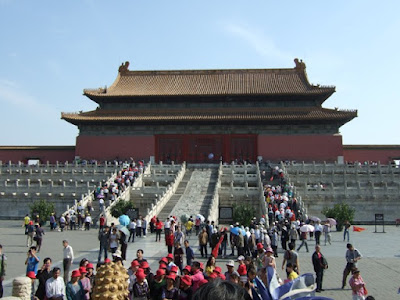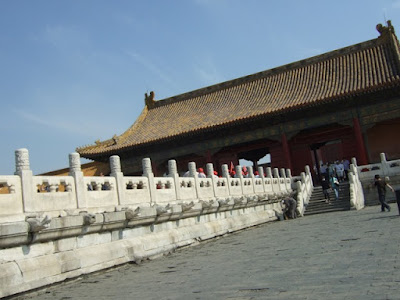 As I walked through the gates, more people greeted me in the face! Guess I have no choice but to squeeze with these people :( Visit to the Forbidden City, now renamed as Palace Museum. With many halls and pavilions, marble railings and steps, the Forbidden City is magnificent.
As I walked through the gates, more people greeted me in the face! Guess I have no choice but to squeeze with these people :( Visit to the Forbidden City, now renamed as Palace Museum. With many halls and pavilions, marble railings and steps, the Forbidden City is magnificent.


 The Wumen Gate (Meridian Gate), the formal entrance to the Forbidden City, was popularly known as Five Phoenix Turrets. It is the largest of the 4 gates of Forbidden City. Measuring almost 38m in height, it is the tallest building in the Forbidden City.
The Wumen Gate (Meridian Gate), the formal entrance to the Forbidden City, was popularly known as Five Phoenix Turrets. It is the largest of the 4 gates of Forbidden City. Measuring almost 38m in height, it is the tallest building in the Forbidden City.
 Got my ticket & the guidebook, time to venture in!
Got my ticket & the guidebook, time to venture in!
 Emperor and his family greeting you as you entered the palace.
Emperor and his family greeting you as you entered the palace.
 Behind the Meridian Gate, one can see 5 bridges with a courtyard named the Inner Golden Water River Bridges. The central bridge was used exclusively by the emperor. The two flanking it were for use by members of the royal family & the two outer bridges were for court officials. The Inner Golden Water River Bridges were supposed to represent the 5 virtues preached by Confucius: Benevolence, Righteousness, Rites, Intelligence and Fidelity. They were shaped like 5 arrows reporting symbolically to Heaven, because the emperor considered himself the Son of Heaven.
Behind the Meridian Gate, one can see 5 bridges with a courtyard named the Inner Golden Water River Bridges. The central bridge was used exclusively by the emperor. The two flanking it were for use by members of the royal family & the two outer bridges were for court officials. The Inner Golden Water River Bridges were supposed to represent the 5 virtues preached by Confucius: Benevolence, Righteousness, Rites, Intelligence and Fidelity. They were shaped like 5 arrows reporting symbolically to Heaven, because the emperor considered himself the Son of Heaven.



 Tai He Men (Gate of Supreme Harmony) is the front gate of the outer court. This is the highest ranking gate in the Forbidden City, where the emperor handled state affairs, listened to ministers' reports and issued imperial edicts.
Tai He Men (Gate of Supreme Harmony) is the front gate of the outer court. This is the highest ranking gate in the Forbidden City, where the emperor handled state affairs, listened to ministers' reports and issued imperial edicts.

 In front of the gate is a pair of bronze lions, the largest pair in Forbidden City. The one on the left (pic above) stepping on a ball is the male, while the one on the right (forgot to take pics!) touching an infant lion with its claw is the female. The male lion symbolize dominant rule over the country and the female represents multiple descendants.
In front of the gate is a pair of bronze lions, the largest pair in Forbidden City. The one on the left (pic above) stepping on a ball is the male, while the one on the right (forgot to take pics!) touching an infant lion with its claw is the female. The male lion symbolize dominant rule over the country and the female represents multiple descendants.

 The Hall of Supreme Harmony rises some 30 meters above the level of the surrounding square. It is the ceremonial center of imperial power, and the largest surviving wooden structure in China. It is nine bays wide and five bays deep, the numbers nine and five being symbolically connected to the majesty of the Emperor.The six pillars nearest the imperial throne are covered with gold, and the entire area is decorated with a dragon motif. The imperial dragon throne, in particular, has five dragons coiled around the back and handrests. The screen behind it features sets of nine dragons, again reflecting the "nine-five" symbolism.
The Hall of Supreme Harmony rises some 30 meters above the level of the surrounding square. It is the ceremonial center of imperial power, and the largest surviving wooden structure in China. It is nine bays wide and five bays deep, the numbers nine and five being symbolically connected to the majesty of the Emperor.The six pillars nearest the imperial throne are covered with gold, and the entire area is decorated with a dragon motif. The imperial dragon throne, in particular, has five dragons coiled around the back and handrests. The screen behind it features sets of nine dragons, again reflecting the "nine-five" symbolism.
 The sloping ridges of the building roofs are decorated with a line of statuettes, led by a man riding on a phoenix and followed by an imperial dragon. The number of statuettes represents the status of the building. The Hall of Supreme Harmony has 10, the only building in the country to be permitted this in Imperial times.
The sloping ridges of the building roofs are decorated with a line of statuettes, led by a man riding on a phoenix and followed by an imperial dragon. The number of statuettes represents the status of the building. The Hall of Supreme Harmony has 10, the only building in the country to be permitted this in Imperial times.


 This is the largest stone carving in the palace, 16.75m long, 3.07 m wide and 1.7m thick, weighs more than 200 tons, hence the name large stone cravings. This was made of a single piece of large blue stone. With beautiful interlocking lotus patterns all around, the huge stone portrayed 9 dragons amidst the clouds, as the dragon is an imperial figure.
This is the largest stone carving in the palace, 16.75m long, 3.07 m wide and 1.7m thick, weighs more than 200 tons, hence the name large stone cravings. This was made of a single piece of large blue stone. With beautiful interlocking lotus patterns all around, the huge stone portrayed 9 dragons amidst the clouds, as the dragon is an imperial figure.
 The Hall of Central Harmony (foreground) and Hall of Preserving Harmony. Hall of Central Harmony is square in shape and served as a resting hall for the emperor to prepare and rest before attending grand ceremonies held in the Hall of Supreme Harmony.
The Hall of Central Harmony (foreground) and Hall of Preserving Harmony. Hall of Central Harmony is square in shape and served as a resting hall for the emperor to prepare and rest before attending grand ceremonies held in the Hall of Supreme Harmony.

 A throne is placed in the centre of the hall and a board hangs above, with an inscription written by Emperor Qianlong. The inscription reads "Yun Zhi Jue Zhong" which means the way to Heaven is profound and mysterious and the way of mankind is difficult. Only if we make a precise and unified plan and follow the doctrine of the mean, can we rule the country well.
A throne is placed in the centre of the hall and a board hangs above, with an inscription written by Emperor Qianlong. The inscription reads "Yun Zhi Jue Zhong" which means the way to Heaven is profound and mysterious and the way of mankind is difficult. Only if we make a precise and unified plan and follow the doctrine of the mean, can we rule the country well.

 Hall of Preserved Harmony, where the emperor changed clothes in this hall before an important ceremony. In the Qing dynasty, the emperor held banquets here for his prices, dukes and ministers of ethnic minorites on the lunar New Year's Eve and the Lantern Festival. The words "Bao He" are from the book of Changes, meaning "maintaining harmony between all things on earth to have a long period of peace and stability".
Hall of Preserved Harmony, where the emperor changed clothes in this hall before an important ceremony. In the Qing dynasty, the emperor held banquets here for his prices, dukes and ministers of ethnic minorites on the lunar New Year's Eve and the Lantern Festival. The words "Bao He" are from the book of Changes, meaning "maintaining harmony between all things on earth to have a long period of peace and stability".
Heading off to bed now, will continue the tour of forbidden city in the next post :)



































